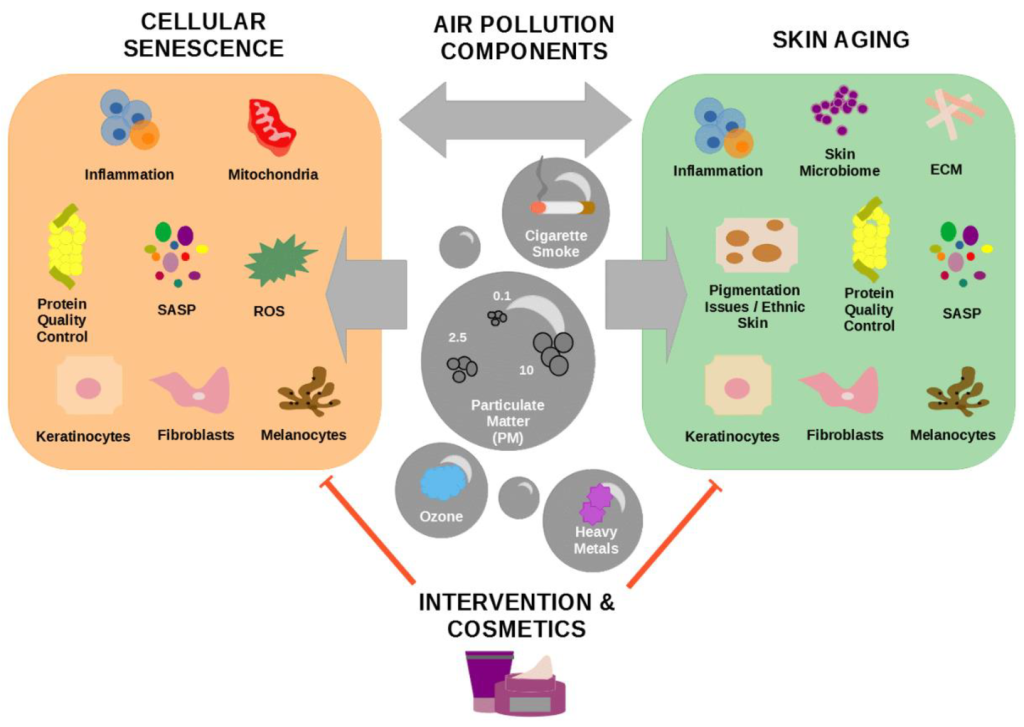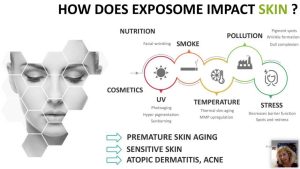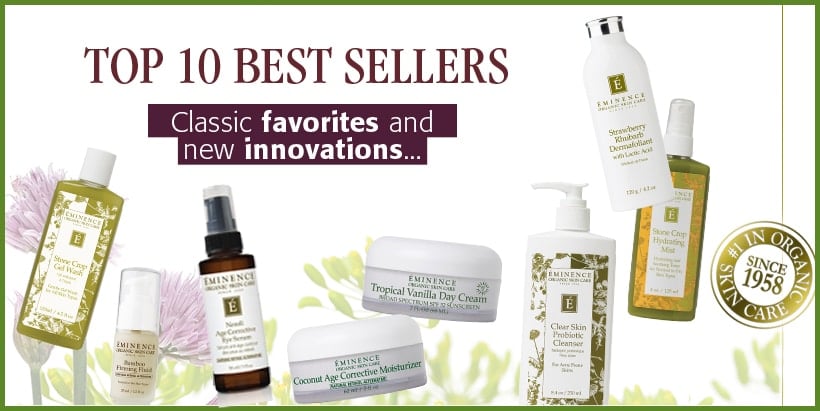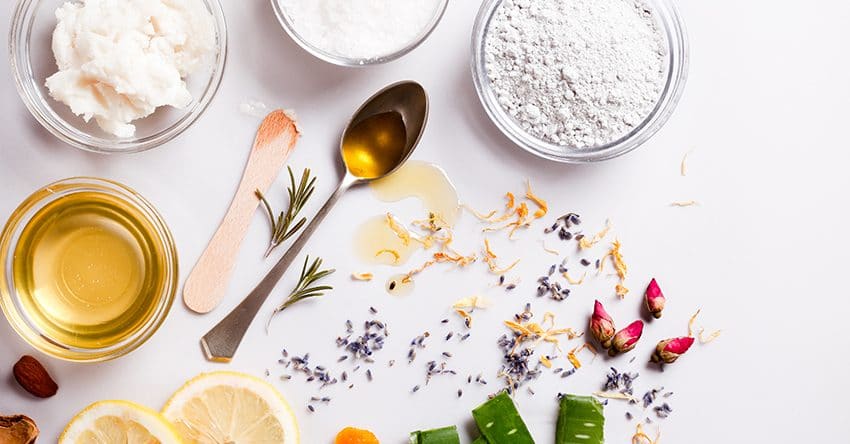How do environmental factors, such as sun exposure and pollution, impact the skin’s aging process? For decades, skincare research has focused on understanding how environmental factors such as sun exposure and pollution can affect the skin’s aging process. This blog post will delve into the complex mechanisms behind environmentally-induced skin aging and provide insights on protecting your skin from these external stressors.
We will explore the role of reactive oxygen species in skin aging and their sources, including oxidative stress and its impact on cellular health. Furthermore, we will discuss ultraviolet radiation’s effects on skin aging by examining UVB vs. UVA rays’ impact on skin health and photoaging due to prolonged sun exposure.
In addition to sunlight-related factors, we will also address infrared-A radiation’s impact on skin health by discussing heat-induced inflammation caused by IR-A exposure and strategies for mitigating IR-A-related damage. How do environmental factors like pollution contribute to skin aging? We’ll cover both outdoor pollutants through aryl hydrocarbon receptors’ roles in dermal degradation and indoor pollution sources and strategies for reducing exposure to these harmful substances.
Lastly, our discussion would be incomplete without touching upon topical antioxidants as a protective measure against environmental stressors. We’ll outline the benefits of topical antioxidants and examples of effective antioxidant-rich skincare ingredients that can help combat premature signs of aging due to environmental aggressors.
Table of Contents:
- The Role of Reactive Oxygen Species in Skin Aging
- Ultraviolet Radiation and Its Effects on Skin Aging
- Infrared-A Radiation’s Impact on Skin Health
- Pollution as an Extrinsic Factor Contributing Towards Skin Aging
- Indoor Pollution Sources and Their Effects on Skin Aging
- Topical Antioxidants as a Protective Measure Against Environmental Stressors
- FAQs in Relation to How Do Environmental Factors, Such as Sun Exposure and Pollution, Impact the Aging Process of the Skin?
- What are the environmental factors affecting the aging process?
- How do environmental factors affect the skin?
- What are the primary environmental factors that contribute to aging and the appearance of aging?
- How does pollution cause skin aging?
- How do natural aging, lifestyle, and environmental factors affect the condition of the skin?
- How does pollution affect aging?
- Conclusion
The Role of Reactive Oxygen Species in Skin Aging
Reactive oxygen species (ROS) play a significant role in accelerating the skin’s aging process. These molecules are generated within cells through various sources, including the nicotinamide adenine dinucleotide phosphate oxidase system, which is crucial for generating oxidative stress that ultimately leads to cellular damage and contributes to skin aging.
Sources of Reactive Oxygen Species Generation
- Sun Exposure: Ultraviolet (UV) radiation from sun exposure can increase ROS production, causing oxidative stress on our skin cells.
- Pollution: Airborne pollutants such as particulate matter and cigarette smoke also contribute to ROS formation, further exacerbating oxidative stress levels.
- Inflammation: Inflammatory processes within the body can generate ROS as part of their normal function but may become harmful when chronic or excessive inflammation occurs.
Oxidative Stress and Its Impact on Cellular Health
Oxidative stress refers to an imbalance between free radicals (such as ROS) and antioxidants within our cells. This imbalance can lead to the deterioration of crucial biomolecules, like DNA, proteins and lipids – all fundamental for sustaining cell health. Over time, this cumulative damage accelerates aging by impairing vital cellular functions such as collagen synthesis (source) and triggering inflammatory responses that further harm our skin’s structure (source).
To counteract the detrimental effects of ROS, our skin relies on a complex network of antioxidants to neutralize these harmful molecules. Nevertheless, conditions such as exposure to sunlight and contamination can surpass our native antioxidant protections, resulting in augmented levels of oxidative strain and subsequent cellular impairment.
To maximize your skin’s protection from environmental damage, it is essential to use topical antioxidants as part of a comprehensive skincare regimen. These powerful ingredients work synergistically with your skin’s natural defense mechanisms to neutralize free radicals before they cause harm.
By understanding the role of reactive oxygen species in accelerating the aging process and taking proactive steps towards reducing their impact through targeted skincare interventions, you can help preserve your skin’s youthful appearance for years to come.
Reactive oxygen species (ROS) involvement in the aging of skin is an essential factor to take into account when examining how external elements impact our epidermis. UV radiation, particularly UVB and UVA rays, has been demonstrated to significantly affect photoaging, which can lead to premature signs of aging.
Key Takeaway:
Sun exposure and pollution can increase the production of reactive oxygen species (ROS) in our skin cells, leading to oxidative stress and contributing to aging. This imbalance between free radicals and antioxidants damages essential biomolecules like DNA, proteins, and lipids, accelerating the aging process by impairing vital cellular functions such as collagen synthesis. To protect your skin from premature aging caused by environmental factors, it’s crucial to incorporate topical antioxidants into your skincare routine.
Ultraviolet Radiation and Its Effects on Skin Aging
Exposure to excessive amounts of ultraviolet radiation (UVR), particularly from sunlight, can lead directly to photoaging and even skin cancer. UVR comprises two main types – solar ultraviolet B (UVB) rays responsible for direct DNA absorption resulting in cell damage, while ultraviolet A (UVA) generates additional reactive oxygen species that further oxidize DNA molecules leading directly to photoaging and tumor initiation.
UVB vs UVA Rays’ Impact on Skin Health
Solar UVB rays, which make up about 5% of the total sun exposure, are known for causing sunburns due to their short wavelength. These rays penetrate the outermost layer of our skin called the epidermis, where they cause direct damage by absorbing into cellular DNA. This leads to mutations that can result in various forms of skin cancer such as basal cell carcinoma or melanoma.
In contrast, solar UVA rays, accounting for approximately 95% of total sun exposure, have a longer wavelength allowing their deeper penetration into our dermis – the second layer beneath the epidermis. Here is where they generate reactive oxygen species that contribute to oxidative stress within cells; this process ultimately accelerates aging signs like wrinkles and sagging by breaking down collagen fibers throughout one’s dermal structure.
Photoaging as a Result of Prolonged Sun Exposure
The term “photoaging” refers to premature aging caused primarily by prolonged exposure to harmful UV radiation emitted from sunlight sources such as tanning beds or natural outdoor settings (source). Visibly, prolonged sun exposure can result in premature aging with signs like wrinkles, fine lines, age spots and an uneven skin tone. Moreover, photoaging also leads to a loss in elasticity due to the degradation of collagen and elastin fibers within our dermal layers.
Preventing photoaging requires consistent use of sun protection measures such as wearing a broad-spectrum sunscreen with an SPF rating of at least 30 or higher (source), seeking shade during peak UV hours (10 AM – 4 PM), and donning protective clothing like wide-brimmed hats or sunglasses that block out harmful UVA/UVB rays effectively.
In addition to these preventative steps, incorporating skincare products containing ingredients known for their ability to repair sun-damaged skin can help reverse some effects associated with extrinsic aging caused primarily through prolonged exposure to ultraviolet radiation sources over time.
Ultraviolet radiation significantly impacts the aging process of skin, with prolonged exposure leading to photoaging. To further understand how environmental factors affect skin health, it is important to consider infrared-A radiation and its effects.
Key Takeaway:
Excessive sun exposure and pollution can lead to premature aging of the skin, also known as photoaging. Ultraviolet radiation (UVR) from sunlight is a major contributor to this process, with UVA rays causing oxidative stress that breaks down collagen fibers and leads to wrinkles and sagging, while UVB rays cause direct DNA damage that can result in various forms of skin cancer. Consistent use of sun protection measures like broad-spectrum sunscreen and protective clothing can help prevent photoaging, along with skincare products containing ingredients known for repairing sun-damaged skin.
Infrared-A Radiation’s Impact on Skin Health
IR-A radiation, in addition to ultraviolet radiation, is a major contributor to skin aging as it causes heat-induced inflammation. The primary mechanism through which IR-A affects the skin is heat-induced inflammation, which can contribute to extrinsic factors affecting overall dermal health preservation efforts throughout one’s lifetime.
Heat-Induced Inflammation Caused by IR-A Exposure
When the skin is exposed to IR-A radiation, it experiences an increase in temperature that triggers an inflammatory response. This process involves the release of pro-inflammatory cytokines and other molecules that cause damage to collagen and elastin fibers within the dermis. These proteins are essential for maintaining firmness and elasticity, so their degradation leads to sagging and wrinkling – common signs of aged skin [1].
Strategies for Mitigating IR-A Related Damage
To protect your skin from infrared-related damage, consider incorporating these strategies into your daily routine:
- Avoid excessive sun exposure: Limiting time spent outdoors during peak sunlight hours (10 am – 4 pm) can help reduce exposure to UV rays and infrared radiation.
- Sun protection clothing: Wearing wide-brimmed hats or long-sleeved shirts with UPF-rated fabric provides additional shielding against UVR and IR-a radiation.
- Sunscreens with antioxidants: Many sunscreens now include antioxidants such as vitamin C or E that may offer some level of protection against IR-A-induced skin damage [2]. Look for products with these ingredients and apply them as directed.
- Topical antioxidant treatments: Applying skincare products containing antioxidants like green tea extract, resveratrol, or niacinamide can help neutralize free radicals generated by IR-A exposure and minimize inflammation in the skin [3].
Incorporating these strategies into your daily routine can help mitigate the damaging effects of infrared radiation on your skin. By taking a proactive approach to sun protection and incorporating antioxidant-rich skincare products, you can preserve your dermal health and maintain a youthful appearance despite increasing environmental stressors.
Infrared-A radiation can have a significant impact on skin health, from heat-induced inflammation to the potential for long-term damage. Pollution also plays a vital role in extrinsic skin aging; therefore, it is essential to understand how these environmental factors contribute to dermal health.
Key Takeaway:
Infrared-A radiation in sunlight can cause heat-induced inflammation and damage to collagen and elastin fibers within the dermis. To protect your skin from infrared-related damage, avoid excessive sun exposure during peak hours, wear protective clothing or sunscreen with antioxidants, and incorporate antioxidant-rich skincare products into your routine.
Pollution as an Extrinsic Factor Contributing Towards Skin Aging
Air pollution, such as smog and particulate matter, can harm our skin’s health and accelerate aging by activating Aryl Hydrocarbon Receptors (AHRs), which trigger NF-B gene transcription leading to inflammatory cytokines release and immune modulator generation. These harmful substances activate aryl hydrocarbon receptors (AHRs), which inadvertently induce transcription of NF-B genes, leading to inflammatory cytokines release and immune modulator generation – all detrimental processes regarding overall dermal health preservation efforts being undertaken at any given point throughout one’s lifetime.
The Role of Aryl Hydrocarbon Receptors in Skin Aging
Aryl hydrocarbon receptors are proteins found within cells that are crucial in detecting environmental toxins. When activated by pollutants like polycyclic aromatic hydrocarbons (PAHs) or dioxins, AHRs initiate cellular responses to detoxify these harmful substances. However, this activation also triggers inflammation and oxidative stress pathways that can damage the skin’s structural components, including collagen and elastin fibers responsible for maintaining its elasticity and firmness.
Inflammatory Cytokines and Their Impact on Dermal Health
In response to pollution-induced AHR activation, our skin produces various inflammatory cytokines such as interleukin-6 (IL-6) and tumor necrosis factor (TNF). MMPs, induced by the inflammatory cytokines, catalyze collagen breakdown in our connective tissues, resulting in skin sagging and wrinkles – critical features of premature aging. This breakdown leads to sagging skin, wrinkles formation, and uneven texture – classic signs associated with premature aging due primarily from extrinsic factors impacting overall dermal health preservation efforts being undertaken at any given point throughout one’s lifetime.
Strategies for Reducing Exposure to Outdoor Pollutants
To minimize the harmful effects of pollution on our skin, it is essential to adopt a few protective measures:
- Avoid high-pollution areas: Avoid heavily trafficked roads and industrial zones where pollutant levels are typically higher. Check local air quality reports regularly and limit outdoor activities during peak pollution hours.
- Cleanse your skin thoroughly: Use gentle cleansers that effectively remove dirt, oil, and pollutants without stripping the skin’s natural moisture barrier. Look for products containing activated charcoal or clay as they can help absorb impurities from the surface of your skin.
- Incorporate antioxidant-rich skincare products: Antioxidants like vitamin C, vitamin E, niacinamide, and green tea extract neutralize free radicals generated by environmental stressors such as UV radiation or pollution exposure. By adding these powerful antioxidants to your routine, you can protect your skin from the premature aging effects of external stressors.
Pollution has been linked to accelerated skin aging, so it is important to be mindful of indoor sources and take steps to reduce exposure for optimal dermal health. Gaining insight into the combination of these elements can help us devise ways to reduce our contact with them and keep a healthy skin condition in the long run.
Key Takeaway:
Exposure to pollution and sun can accelerate skin aging by activating aryl hydrocarbon receptors (AHRs) that induce inflammatory cytokines release, leading to collagen breakdown and wrinkles formation. To reduce exposure, avoid high-pollution areas, cleanse your skin thoroughly with activated charcoal or clay products, and incorporate antioxidant-rich skincare products like vitamin C and green tea extract into your daily routine.
Indoor Pollution Sources and Their Effects on Skin Aging
While outdoor pollution is often the primary focus when discussing environmental factors affecting skin health, indoor pollutants can be just as harmful. These sources of indoor pollution exacerbate existing problems associated with extrinsic factors impacting overall dermal health preservation efforts throughout one’s lifetime.
Common Indoor Pollution Sources
- Cigarette smoke: A well-known source of harmful chemicals, cigarette smoke contains thousands of toxic substances that can cause oxidative stress and inflammation in the skin, leading to premature aging. Secondhand smoke exposure also poses a risk for non-smokers.
- Cooking and heating with coal or wood: Burning these materials releases particulate matter into the air, irritating and damaging your skin. Combustion processes such as burning coal or wood, candles, and fireplaces can generate PAHs which promote oxidative stress in cells.
- Candles and fireplaces: Like cooking with coal or wood, burning candles or using fireplaces releases soot particles that contribute to poor indoor air quality. Scented candles may be a source of VOCs, which have been associated with respiratory problems and potential skin damage.
Strategies for Reducing Exposure to Indoor Pollutants
To minimize your exposure to these common indoor pollution sources while maintaining healthy-looking skin at any age, consider implementing some simple strategies within your home environment:
- Improve ventilation: Increase airflow by opening windows regularly or installing exhaust fans where necessary. This helps to remove pollutants and maintain a healthier indoor environment.
- Use air purifiers: Air cleaners equipped with HEPA filters can effectively capture particulate matter, reducing the concentration of airborne particles that may irritate your skin.
- Avoid smoking indoors: If you or someone in your household smokes, establish designated outdoor areas for smoking to minimize exposure to secondhand smoke inside the home.
- Choose safer alternatives: Opt for cleaner-burning candles made from soy or beeswax instead of paraffin wax, which releases more soot when burned. Additionally, consider using electric fireplaces or heaters as an alternative heat source during colder months.
Incorporating these strategies into your daily routine can help reduce indoor pollution levels while supporting overall skin health preservation efforts against extrinsic aging factors throughout one’s lifetime. Remember that maintaining a healthy lifestyle and adopting effective skincare routines are also essential components in combating environmental stressors on our skin caused by sun exposure and pollution.
Reducing exposure to indoor pollution sources is essential for preserving the skin’s youthful appearance and should be included in a skincare routine that includes topical antioxidants. Incorporating topical antioxidants into one’s skincare regimen can help to guard the skin from environmental harm.
Key Takeaway:
Indoor pollution sources like cigarette smoke, cooking and heating with coal or wood, and candles can contribute to premature aging of the skin. To reduce exposure to these pollutants, improve ventilation, use air purifiers with HEPA filters, avoid smoking indoors, and choose safer alternatives such as soy or beeswax candles.
Topical Antioxidants as a Protective Measure Against Environmental Stressors
Emerging evidence suggests that topical application of antioxidants such as vitamins C and E can help prevent the formation of oxidation products in the skin caused by exposure to UV radiation and other pollutants. By replenishing depleted antioxidant levels in the skin, these treatments may offer some protection against harmful effects while potentially reversing signs associated with extrinsic aging.
Benefits of Using Topical Antioxidants
Topical antioxidants have been shown to provide numerous benefits for maintaining healthy skin. These include:
- Fighting free radicals: Antioxidants neutralize reactive oxygen species (ROS) generated from sun exposure, pollution, and other environmental stressors, reducing oxidative stress on the skin.
- Promoting collagen production: Some antioxidants stimulate collagen synthesis, which helps maintain firmness and elasticity in the skin.
- Brightening complexion: Vitamin C is known for its ability to brighten dull complexions by inhibiting melanin production responsible for hyperpigmentation or dark spots.
- Soothing inflammation: Certain antioxidants possess anti-inflammatory properties that can calm irritated or inflamed skin conditions like acne or rosacea.
Examples of Effective Antioxidant-Rich Skincare Ingredients
In addition to vitamins C and E, several other potent antioxidant-rich ingredients are found in organic skincare products that can protect your skin from environmental damage. Consider incorporating these into your routine:
- Niacinamide: Also known as vitamin B3, niacinamide is a powerful antioxidant that helps improve skin elasticity, reduce redness and inflammation, and minimize the appearance of fine lines.
- Green tea extract: Rich in polyphenols like epigallocatechin gallate (EGCG), green tea extract offers potent antioxidant protection against UV radiation and pollution-induced oxidative stress. It also has anti-inflammatory properties to soothe irritated skin.
- Ferulic acid: Found in plant cell walls, ferulic acid stabilizes other antioxidants, such as vitamins C and E, while providing its own protective benefits against environmental damage. When combined with these vitamins, it enhances their overall effectiveness.
- Astaxanthin: Derived from microalgae or yeast fermentation processes, astaxanthin is a carotenoid pigment with intense antioxidant activity. It can help protect the skin from sun exposure-related damage by neutralizing free radicals from UV radiation.
By selecting organic skincare products with potent antioxidants, such as astaxanthin, you can help protect your skin from the damaging effects of UVR and environmental pollutants. By choosing products containing these powerful ingredients, you’re taking proactive steps toward maintaining healthy, youthful-looking skin for years to come.
Key Takeaway:
Topical antioxidants like vitamins C and E can protect the skin from harmful environmental factors such as sun exposure and pollution. They fight free radicals, promote collagen production, brighten complexion, and soothe inflammation. Other effective antioxidant-rich skincare ingredients include niacinamide, green tea extract, ferulic acid, and astaxanthin.
FAQs in Relation to How Do Environmental Factors, Such as Sun Exposure and Pollution, Impact the Aging Process of the Skin?
What are the environmental factors affecting the aging process?
Environmental factors that contribute to skin aging include sun exposure, pollution, and oxidative stress. Prolonged sun exposure leads to photoaging, while pollution can cause cellular damage and inflammation. Oxidative stress from free radicals also accelerates skin aging by damaging collagen and elastin fibers.
How do environmental factors affect the skin?
Environmental factors like ultraviolet radiation (UVR), infrared-A radiation (IR-A), pollution, and oxidative stress can lead to premature skin aging. They cause cellular damage, reduced collagen production, inflammation, dryness, uneven pigmentation, or age spots on your complexion.
What are the primary environmental factors that contribute to aging and the appearance of aging?
The primary environmental contributors to visible signs of skin aging are sun exposure (UVR), IR-A radiation from sunlight or heat sources, indoor and outdoor pollutants such as smog or cigarette smoke, and oxidative stress.
How does pollution cause skin aging?
Pollution causes skin-aging effects, including fine lines, wrinkles, and dullness due to increased levels of reactive oxygen species (ROS) in cells leading to DNA damage and inflammatory responses, which break down collagen and elastin fibers responsible for maintaining youthful elasticity in our complexion.
How do natural aging, lifestyle, and environmental factors affect skin conditions?
Natural lifestyle choices like diet and exercise influence overall health, including skin conditions. Environmental factors like sun exposure, pollution, and oxidative stress contribute to premature aging by causing cellular damage, inflammation, and collagen degradation. A balanced lifestyle with proper skin care can help maintain healthy skin.
How does pollution affect aging?
Pollution accelerates aging by increasing oxidative stress, leading to DNA damage and inflammatory responses that break down collagen and elastin fibers responsible for maintaining youthful elasticity in our complexion.
Conclusion
External elements such as sunlight and contamination can significantly affect skin aging. UV radiation from prolonged sun exposure can cause cellular damage and photoaging, while IR-A radiation can negatively affect collagen production. Pollution sources, both outdoors and indoors, can also be detrimental to your complexion.
To counteract these effects, incorporating topical antioxidants into your skincare routine can help protect against oxidative stress. Choosing organic skincare products with ingredients rich in antioxidants is also important for healthier skin.
If you want to improve your skin’s health and combat the effects of environmental factors on aging, consider trying organic skincare products from Organic Skincare. Take care of your skin now to maintain its youthful appearance for years to come!




